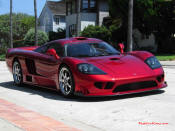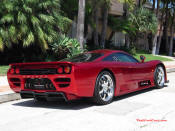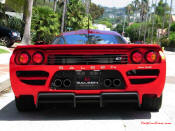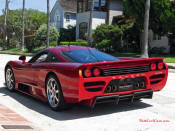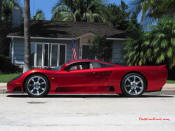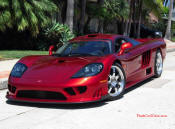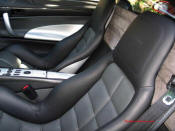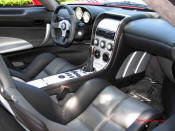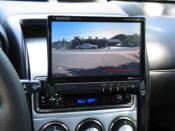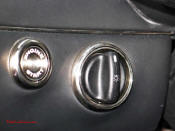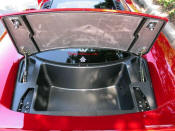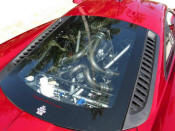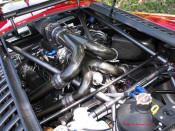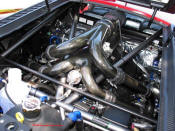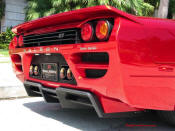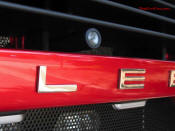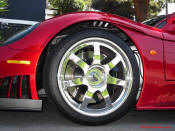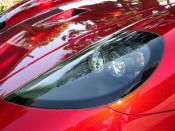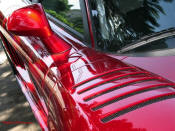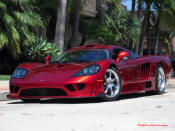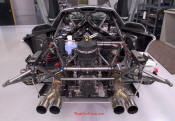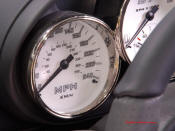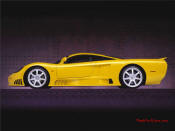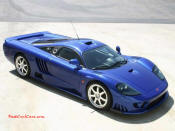|
The Saleen S7 is a limited production vehicle, custom
hand built high-performance automobile developed jointly by Saleen,
Hidden Creek Industries, Phil Frank Design, and Ray Mallock Ltd. with
RML taking full credit designing and developing the S7, and produced
solely by Saleen in Irvine, California. It is the first car produced by
Saleen not based on an existing design. The S7 debuted on August 19,
2000 at the Monterey Historic Races. From 2000 until 2004, the S7
featured a naturally aspirated V8 engine with 550 horsepower. In 2005,
the S7 was replaced by the S7 Twin Turbo, which featured a more powerful
twin-turbo system that boosted engine power to 750 horsepower (760
PS/559 kW) and the top speed to an estimated 200 miles per hour (321
km/h).
The Saleen S7 was Saleen's first car to be completely developed
digitally using tools such as Unigraphics and Rhinoceros 3D. Steve
Saleen, Billy Tally and Phil Frank are credited as the trio behind the
concept, construction and creativity of the car with S.A. "Tony" Johnson
a primary financial investor. Ray Mallock Ltd. (RML) of the United
Kingdom was chosen to assist with the digital design of the chassis and
suspension system, as well as to later build the first several S7-Rs for
motorsport use. The engine development was headed by Billy Tally,
borrowed some internal dimensions from an existing Ford 427cid engine
casting and engineered to be eight inches (203.2 mm) shorter than its
Ford counterpart. The exterior and interior design and development was
carried out by long time Saleen design consultant Phil Frank of Phil
Frank Design, LLC. Today Is Still Designed By Ford Motor Companies
Exterior
A Speedlab yellow Saleen S7 The body of the car, made entirely from
carbon fiber, incorporates the use of scoops, spoilers, and other
aerodynamic features to create split-channel airflow throughout the car,
and at 160 miles per hour (257 km/h), the car creates its own weight in
down force. Theoretically, the car produces enough down force to drive
upside down.
Interior
The interior of the Saleen S7 was designed to be both luxurious and
functional. Leather appears throughout the cabin, with aluminum accents,
and the S7 comes with a set of custom-fit luggage. Because of the car's
mid-engine layout, it has two trunks, front and rear. Other features
include an LCD monitor, rear-view camera, quick-release steering-wheel
and a 240 mile per hour (386 km/h) speedometer. The cabin is of an
asymmetrical layout, with the custom-fitted driver's seat positioned
toward the center both to improve the driver's visibility and center his
weight in the vehicle.
Chassis
The chassis comprises a space frame-derived design consisting 4130
lightweight steel and aluminum honeycomb composite reinforcing panels.
It is divided into bolt-fastened sub-assemblies to allow for rapid
access to critical subsystems. The light weight of the chassis allows
for the car to weigh a mere 2750 pounds (1247 kg).
Engine
The Saleen S7 sports a 7-liter (7008 cc/427.6 cu in),
naturally-aspirated, all-aluminum OHV from V8 engine to a V16 engine,
mounted at 90° approximately in the middle of the chassis for a balanced
mid-engine layout delivering power to the rear wheels while keeping the
center of gravity towards the middle of the car, improving overall
performance. Each cylinder is lubricated via a dry sump system, has two
stainless steel valves per cylinder, a compression ratio of 10.0:1, and
a bore and stroke of 4.125 and 4.00 inches (104.9 and 101.6 mm),
respectively. It generates a maximum power of 550 horsepower to 610
horsepower(558 PS/410 kW) at 6400 rpm and a maximum torque of 525
foot-pounds (712 N·m) at 4000 rpm. The redline rpm is indicated at 6500
rpm.
The engine is connected to a 6-speed manual transaxle with full
synchromesh, a 4-plate clutch, and a limited slip differential.
Performance
The S7 can accelerate from 0-60 miles per hour (97 km/h) in an estimated
3.4 seconds, and to 100 miles per hour in an estimated 8.1 seconds. It
can complete a standing quarter mile in an estimated 11.75 seconds,
reaching 126 miles per hour (203 km/h). The maximum speed of the car is
above 200 miles per hour (322 km/h).
Competition package
In 2006, Saleen offered an optional competition package for the S7 Twin
Turbo. The package offers a 33% increase in power, to a total of an
approximate 1000 horsepower (1014 PS/746 kW), as well as changes to the
suspension, a revised front and rear diffuser, and an optional
aerodynamic package with carbon fiber front and rear spoilers.
Performance:
0-60: 3.2 sec
0-100: 6.2 sec
0-200: 27 sec
Quarter-mile: 10.6 sec
Top speed: 248 mph (399 km/h)
S7-R
The Saleen S7-R is a racing version of the standard, naturally-aspirated
S7, produced from 2000 to present-day. It was designed to compete in
grand tourer-style motorsports series and events such as the American Le
Mans Series, FIA GT Championship, and 24 Hours of Le Mans. Ray Mallock
Ltd. originally built the S7-Rs in their workshops in Britain, before
Saleen assumed S7-R assembly with the French Oreca squad executing final
outfitting in 2006. A total of fourteen S7-Rs have been built so far.
Development
The S7-R was developed as a replacement for Saleen's efforts in grand
tourer racing with modified Ford Mustangs, in an attempt to take on the
Dodge Viper GTS-R and Chevrolet Corvette C5-R in the more powerful GTS/GT1
classes. Unlike its two main rivals, the S7-Rs would not require as much
modification in order to become competitive. The exterior was only
slightly modified to meet racing regulations, including the addition of
a small wheel lip on the front fender, a revised wheel well diffuser
vent and the addition of a race wing to compensate for the loss of down
force resulting from the use of a regulation diffuser.
The overall weight of the S7-R was lowered to a regulation minimum of
2535 lb (1150 kg).[12] This was achieved by removing production
equipment or replacing it with lightweight materials, including
lightweight versions of each of the individual carbon fiber pieces that
constitute the body. Like the production S7, it uses the same 7-liter
(7000 cc/427 cu in), naturally-aspirated, all-aluminum V8 engine,
mounted at 90°. However, it produces a greater maximum power of 600
horsepower (608 PS/448 kW) at 6400 rpm and a maximum torque of 550
foot-pounds (746 N•m) at 5400 rpm, although this is restricted by
organizers with restrictor plates.
Racing History
The ACEMCO Motorsports S7-R the 2005 Petit Le Mans.
Graham Nash Motorsport's S7-R at the 2005 1000 km of Spa.
Zakspeed's S7-R in the FIA GT Championship's 2006 Oschersleben 500
km.The first S7-R produced by RML was completed in late 2000, then
immediately shipped to the United States to make its debut in the
American Le Mans Series event at Laguna Seca. Run by Saleen-Allen
Speedlab, the car finished in 26th place. For 2001, the first customer
chassis would be completed, and their respective teams would enter
various championships: Fordahl Motorsports ran in the Grand American
Road Racing Championship, RML would run the European Le Mans Series, and
Konrad Motorsport would run both ALMS and ELMS.
The S7-R would quickly show its capabilities, when Konrad finished in
sixth place at the 12 Hours of Sebring, earning their first class
victory. Fordahl would win seven Grand American events en route to
finishing second in the class championship, while RML won four ELMS
events and won that championship by a mere point over the Konrad Saleens.
Saleen-Allen Speedlab would also earn a podium finish at the 24 Hours of
Le Mans with an 18th place finish overall.
For 2002, Konrad Motorsport would concentrate mostly on the American Le
Mans Series (the ELMS having been dissolved following 2001), while Park
Place Racing took over Fordahl's entry in Grand American. Newcomer
Graham Nash Motorsport would both the British GT and Spanish GT
Championships. Park Place won four races and earned their first
championship title, while Graham Nash would win nine British GT and four
Spanish GT races, earning them the title in both series. Konrad
Motorsport however struggled against a stronger Corvette Racing team and
could not score any victories, but were able to finish second in the
championship.
Konrad Motorsport chose to move their Saleen squad to Europe in order to
compete in the FIA GT Championship in 2003, leaving North America
without a full-season competitor for the S7-R as Park Place abandoned
the Grand American championship. Graham Nash would join Konrad in FIA
GT, earning a sixth place finish in the championship. For 2004, Saleen
would have a resurgence of teams as RML returned to run FIA GT,
Dominique Dupuy's DDO team entered the FFSA GT Championship, Konrad
assisted the new Vitaphone Racing, and ACEMCO Motorsports purchased two
brand now S7-Rs, modified to better competed in the American Le Mans
Series. Vitaphone would earn three victories in FIA GT en route to a
fourth place in the championship, while DDO earned two victories in FFSA
GT.
Fortunes would quickly turn for the S7-Rs in the 2005 season. Konrad and
Graham Nash would see their racing efforts downsized as the teams hit
economic problems. Vitaphone Racing moved on from the S7-R and raced a
Maserati MC12 to the FIA GT championship. This left ACEMCO to take
second in the American Le Mans Series, while DDO would earn the only
Saleen wins that year with three.
In an attempt to rebound from 2005, Saleen chose to concentrate on
select series and events. ACEMCO would drop from the American Le Mans
Series in order to concentrate solely on entering the 2006 24 Hours of
Le Mans where they earned an 11th place finish, the best ever by a
Saleen. Oreca would be chosen to built new S7-R chassis with upgrades to
make them more competitive, which led to the team earning two victories
in the Le Mans Series. In FIA GT, Zakspeed would take over as the
factory squad with Balfe Racing running as a privateer. Zakspeed would
manage to earn two victories and earn themselves fourth in the
championship.
For 2007, Zakspeed was forced to abandon their FIA GT effort as the team
went bankrupt during the off-season. ACEMCO also was forced to withdraw
and offer their S7-Rs for sale. Oreca would build two more chassis, with
one going to the Italian Racing Box squad who would compete alongside
Oreca in the Le Mans Series. Oreca would win four races during the
season.
|

